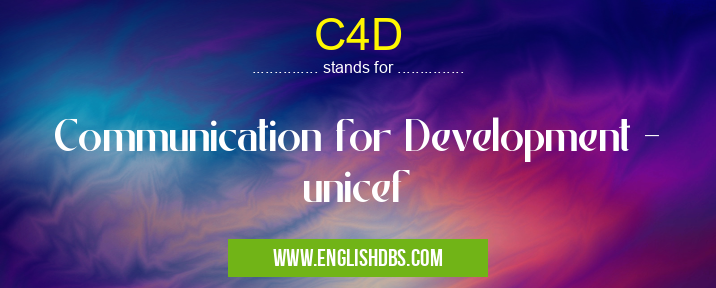What does C4D mean in DEVELOPMENT
Communication for Development (C4D) is an approach to development that views communication as a critical tool to support people’s development goals and promote social change. It is not simply about disseminating information, but rather about engaging people in conversations and building relationships. This holistic approach uses different types of communication tools, including modern media technologies, radio, television and mobile phones. C4D has become increasingly popular among governments, non-governmental organizations (NGOs), communities and individuals as it empowers people to take control of their lives by enabling them to access knowledge and resources.

C4D meaning in Development in Community
C4D mostly used in an acronym Development in Category Community that means Communication for Development - unicef
Shorthand: C4D,
Full Form: Communication for Development - unicef
For more information of "Communication for Development - unicef", see the section below.
» Community » Development
Essential Questions and Answers on Communication for Development - unicef in "COMMUNITY»DEVELOPMENT"
What is Communication for Development (C4D)?
Communication for Development - or C4D - is an approach that focuses on how communication strategies, techniques and tools can be used to help achieve development objectives. It also emphasizes the importance of dialogue between individuals, communities and organizations in order to create effective solutions
What specific goals do C4D programs work towards?
Goals vary depending on the nature of the particular program, but typically they aim to facilitate behavior change in children and adults; increase knowledge, skills and understanding; strengthen media capacities; or empower people in their social relationships.
How does C4D differ from traditional development initiatives?
Traditional approaches focus largely on providing physical resources such as food, water, or medicine whereas C4D takes more of a holistic approach by considering the needs of the entire community through careful listening and communication. This ensures that solutions consider a broader scope of needs when addressing specific challenges.
What methods does UNICEF use in its C4D interventions?
UNICEF uses a variety of communication methods such as theatre, radio broadcasts, texting campaigns, interactive digital programming, storytelling, counseling sessions and other forms of multimedia outreach in its C4D initiatives. Each method is tailored to respond to different individual and collective learning needs across various contexts.
Are there any lasting effects achieved through C4D initiatives?
Yes! By providing access to information about health issues such as hygiene practices or nutrition habits will help ensure these changes become part of daily life long after the intervention period ends. Additionally, improved dialogues between community members allows for better understanding which can lead to enhanced decision-making over time regarding important topics like education or disaster risk reduction.
How has technology changed the way aid organizations communicate with stakeholders?
Technological advancements have allowed aid organizations like UNICEF greater opportunities for speed and scale within their communications strategies - creating new ways for messages to reach large numbers of people. The increased use of mobile phone technology has been particularly helpful in reaching under-served rural populations in many parts of the world who may not have access to other forms of communication like television or newspapers.
Are there any risks associated with using technology for communication purposes?
The potential benefits come with certain risks related to accuracy and credibility - especially when communicating sensitive topics or information meant for public consumption - so it’s important for communicators at all levels (including those at aid organizations) to be particularly conscious when using digital tools like text messages within their projects.
How do local dynamics influence how well-received a message might be?
Local dynamics are very important factors in determining whether a message will be understood by its intended audience or not. Cultural sensitivities must be kept in mind when crafting messaging around complex topics such as politics or religion which could easily be misinterpreted if not done so carefully.
Final Words:
In conclusion, Communication for Development (C4D) provides a powerful tool that can be used by different stakeholders in order to create dialogue and interaction between them which can lead towards improved understanding and overall progress in society. Its ability to foster collaboration among different actors makes it an invaluable asset that should be embraced both at local levels as well as within the international community alike.
